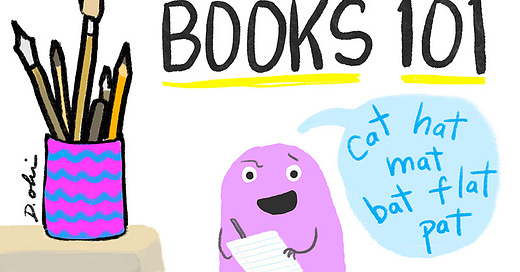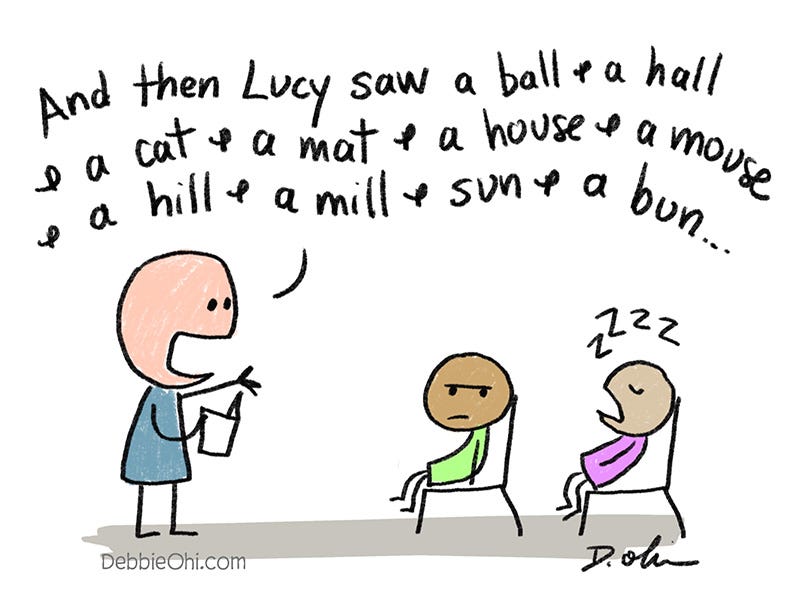Picture Books 101 (Part 4): To Rhyme Or Not To Rhyme?
It's hard to write a GOOD rhyming picture book. Here are some tips from the experts.
Hi, I’m Debbie Ridpath Ohi! Welcome to Part 4 of my Picture Books 101 post series, which focuses on the basics of writing and illustrating picture books for traditional publishing houses.
In Part 4, I’m focusing on rhyming in picture books.
Picture books don’t have to have rhyming text.
Some beginning picture book writers, especially those unfamiliar with modern-day picture books, assume that all picture books have to have rhyming text. Tip: Read LOTS of picture books, especially those published recently.
It’s hard to write a GOOD rhyming picture book.
This is the main reason I haven’t yet attempted it myself. I love poetry and writing poetry (and have even been paid for my poetry), but that doesn’t mean I’m able to write a good rhyming picture book.
Having a good story is more important than your rhymes.
Don’t let your rhymes dictate what happens in your story.
Don’t use rhyming as a crutch. When I interviewed Justin Chanda, my editor at Simon & Schuster, about the biggest mistakes that new picture book writers tend to make, he said that too many think that rhyming solves everything.
“Rhyme is the car, story is the road. “
- Rebecca Grabill
“Rhyme is the car, story is the road,” says Rebecca Grabill in her Lessons in Rhyme: How To Write A Rhyming Picture Book.
Aim for natural-sounding syntax.
Sometimes new picture book writers twist sentence structure and phrasing to make a rhyme work, and it ends up sounding awkward. See Rebecca Grabill’s article for specific examples and tips. “Even in rhyme, Bateman’s characters have distinct voices, and nowhere does she sacrifice graceful syntax for the sake of the rhyme,” says Rebecca when discussing Teresa Bateman’s rhyming text in A Plump And Perky Turkey.
Josh Funk, who writes GOOD rhyming picture books, explains more about Bad Rhyme (and gives examples of what he calls “rhyme crime”) in his post, Don’t Write In Rhyme.
Meter isn’t just about counting syllables.
“Even writers who are great at coming up with natural rhymes often stumble with meter in a picture book,” says Kate Messner. “Contrary to popular belief, meter isn’t just about counting the syllables in each line. It’s about paying attention to stressed and unstressed syllables.” See Kate’s blog post, Writing In Rhyme (Is A Lot Tricker Than You Might Think).
“Rhythm is far more important than rhyme,” says Josh Funk in one of his posts about rhyming picture books. Having a good story is the most important, says Josh. After that, the second most important aspect is rhythm. “Rhyming picture books are all about the rhythm.”
Look for unexpected rhymes.
Avoid end rhymes that have already been done a zillion times.
“The point of rhyming children’s books isn’t to find a word that works and wedge it in somehow, the point of rhyme is to delight, impress, and surprise,” says Mary Kole in her Writing Rhyming Children’s Books post on Kidlit.com. “If I see an unexpected rhyme in a manuscript, that immediately tells me that the writer knows what they’re doing.”
Some agents and editors avoid rhyming picture books.
Because there are so many BAD rhyming picture books being sent out, there is a stigma associated with rhyming picture books. “I got a very painful looking cringe from a highly respected and successful agent when I told her I wrote picture books in rhyme, “ says Josh Funk. “– A look you might give someone when they tell you their dog died … a horrific death.”
Also, be aware that rhyming picture books can’t be easily translated, which impacts potential foreign rights sales.
A good test: read your picture book text out loud.
Reading your picture book text aloud is always a good test, especially for rhyming picture books. Are there bits where you tend to always stumble? Are there places where you have to squash syllables to make the meter work? You probably need to revise.
Read many recently published picture books.
One of the best ways to learn about how to write picture books is to read many, many picture books, and aim to find out what is being currently published. Too many writers have the attitude, “It’s super-easy to write picture books. I’ll write books like the ones I remember from my own childhood.”
Examples of GOOD rhyming picture books:
These are just a few examples based on recommendations from the experts. Do you have other suggestions of good rhyming picture books? Feel free to post in the comments!
It’s also worth searching online for educator recommendations about rhyming picture books, especially articles that explain WHY these books are being recommended. Examples: 30+ Rhyming Books For Preschool & Kindergarten and 20 Teacher Recommended Picture Books That Rhyme: Phonemic Awareness, Rhyming, Book Lists.
Questions? Comments? Suggestions for future newsletter topics? Feel free to let me know!
Related Resources:
Also, see responses to my recent post on X (formerly known as Twitter 😜) asking for recommendations and my List Of Traditionally Published Children’s Book Illustrators On Substack.
Josh Funk’s Guide To Writing Picture Books - Especially see Lesson 8 and 9, specifically rhyming.
Renee LaTulippe’s Lyrical Language Lab - Also see Renée’s YouTube channel!
Writing In Rhyme (is a lot trickier than you might think) - by Kate Messner.
RhymeWeaver.com - Nuts and bolts tips about rhyme and meter, the publishing industry, and more.
Rhyming Picture Book Pointers from Anne Marie Pace - on Tara Lazar’s blog. “If you set your reader up to expect a rhyme or a particular beat, you need to keep that promise.”
Lessons In Rhyme: How To Write A Rhyming Picture Book - by Rebecca Grabill. Gets into the nuts and bolts of word choice and rhyming.
Writing Rhyming Children’s Books - by Mary Kole on Kidlit.com.
How To Write A Rhyming Picture Book - on GoodStoryCompany.com.
RhymeDoctors.com blog - Picture book authors who offer free tips on rhyming in addition to their editing services.
More info plus free templates at my Creating Picture Books resource:
Do you have suggestions for other resources? Have you written a post on Substack about rhyming in picture books? Feel free to post the link in the comments!












Good tips. Putting them into practice is the hard part! But it's such a delight for the reader when it's done well, not to mention immensely satisfying for the author who nails it.
Yes, yes, yes! Great tips, Debbie, on writing in rhyme! I'm a huge fan of Renée LaTulippe's mini Youtube videos and her Lyrical Language course. And I think that Rebecca Gardyn Levington should also be included in your list of peeps who write well in rhyme.